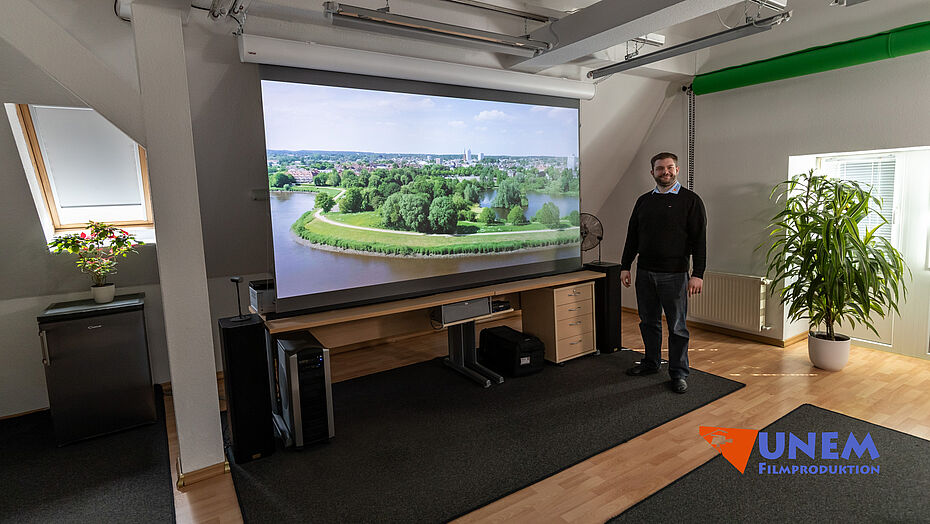
„Digital film vs. Video “- Simply explained for customers
Nowadays cameras are mostly digital, i.e. files are saved during recording. This applies equally to moving pictures and photos. But why do professional cinematographers refer to certain camera models as digital film or cinema cameras? A film camera needs analog film – celluloid doesn‘t it?
The professional world speaks of digital film whenever the images have to be “developed” first in post-production on the computer - similar to analog film. Film material has to be chemically developed in a laboratory before a viewer can view the moving pictures with a cinema projector. In the case of digital film, this intermediate step is carried out using a computer program: color grading - that is, the development of digital film.



Image examples film vs video
The following three "screen shots" in the respective film and video mode illustrate how different the images from digital film cameras can look:
* Note movie files raw mode, even for viewing the images must be color graded.
Picture 1 shows the look of an unprocessed file from a digital film camera (flat, log). Picture 2 shows the finished moving picture, graded by the colorist. Picture 3 simulates a video image in which the camera automatically performs the work of a "colorist" internally.
The difference between digital film and video
The main differentiator between video files and digital film files is that digital film is raw and video has a given look - it's almost done. As can be seen in Picture 1, an unprocessed digital film image is dark, flat, low-contrast and colorless. While a video image appears high-contrast, colored and bright.
Advantages and disadvantages of digital film (digital negatives)
As described, flat or LOG images have to be developed or color graded in post-production before you as a viewer can see a beautiful moving image on your TV or computer monitor. What are the advantages of color grading? Due to their LOG gradation, digital film cameras represent more dynamics in the picture. This means that the digital film shows no or less overexposure in the image - similar to celluloid film. Professional cameramen evaluate beautiful images in the first instance according to their dynamics or the contrast between light and dark. Let us look at our example pictures 1 and 2. Both represent a recognizable drawing in the shadows and a good representation of bright highlights within the clouds, without the bright structures burning out. Picture 3 shows a video look in which individual cloud structures are burned out white and cannot be “brought back” even in post-production.
Demand for digital film
TVs are getting bigger and better technologically. They show more and more dynamic range and even outperform cinemas in terms of quality. TVs can display more picture quality than TV stations can broadcast today. These screens require acquisition formats with great image quality that only digital film cameras / cinema cameras can record.
Celluloid film - the film look
Some Hollywood directors such as Christopher Nolan or Quentin Tarantino still use cinema cameras with celluloid. Why? Because the cinema film look plays a unique role in our pop culture. The cinema viewers have internalized the film look as the ultimate standard for moving images - as a reverence.
The digital film also follows this reference. Before it gets really complicated - a complete description of the film look is complex, since there are many other properties to consider, such as sensor size, resolution, frame rate, color space, lighting design or even stage design. Color grading is a tool of this art form, because a special color aesthetic can reach viewers even on an emotional level.
Digital camera systems compared to price and quality
| Film vs Video | Brand + Type | Application | Price [€] ready to shoot |
| Cinema camera | ARRI Alexa | Highend Cinema, HQ-Streaming* | >95k |
| Cinema camera | RED Helium | Highend Cinema, HQ-Streaming* | >50k |
| Cinema camera | Sony fs7 | Midrange Cinema, TV | >15k |
| Cinema camera | Canon C200 | Midrange Cinema, TV | >14k |
| Video camera | Canon XF400 | Lowrange TV, Home-TV | <2k |
| Smartphone | iPhone 11 Pro | Lowrange Smartphone-Displays | >0,8k |
Future digital
High-end digital film cameras are now as good or better than analog film. Roger Deakins is one of the most successful cameramen (Director of Photography) in the film industry. He was the cinematographer for numerous films such as Bladerunner 2049, James Bond Skyfall, The Shawshank Redemption and many other productions.

Conclusion
Digital film creates an image aesthetic that comes close to the reference, the film look. The ability to color grade the moving images in post-production creates images with a large dynamic range that simply look great on modern 4k TVs.
The fact is, the larger the TV for moving images, the more clearly differences in quality become visible between a cinema camera and a smartphone.
Video production vs. Film production means documentary image characteristics vs. telling stories and reaching viewers on an emotional level, both in the feature film as well as in image films and advertising. Smartphone "videos" may be nice, but customers can very well see the difference, especially when the TVs get bigger and the content becomes higher quality.
We rely on digital cinema cameras for our advertising and image film productions and also use cinematic design tools to bring the message closer to the viewer in an interesting way.
Sometimes it can be enough that the film director let the CEO repeat his statement several times to sharpen the message. The more beautiful moving picture is produced by a film production with a digital cinema camera and the associated know-how. In our studio in Itzehoe, our customers can marvel the films we produce for them on a 120 inch (3m diagonal) 4k cinema screen.
One more reason for professional advertising - film production. Feel free to get in contact :
UNEM-Filmproduktion
Michael Großmann & Helmut Schnock GbR
Lohweg 2
25524 Itzehoe
04821-8881130
m.grossmann@unem.de
[1] Source: filmpuls.info | Online magazine marketing, pr and communication using film and video
https://filmpuls.info/arri-alexa/
Blog Article
- Advertising Film Personal Rights Employees and Actors
- „Digital film vs. Video “- Simply explained for customers
- „Commercials with the Canon R5” - 4K or not 4K
- 4K Resolution for Corporate Videos
- Ad hoc presenting films in meetings or at trade shows
- 4k filming with a Canon 1DX Mark2 – DSLR
- Imagefilms in the Modern Brand Management
- Industrial film production for manufacturer of medical products
- Canon DSLR Short Film Heart Racing - 7D, 550D, 5D MarkII
- Compositing – Car Crash as a Special Effect for a Short Film
- Compositing – The Businessman – From Drawing to the Film
- Mobile Film Studio – Appealing Product Films at the Client Site
- Bluescreen Studio – Technique and Application Examples
- Shooting Report Corporate film with DSLR and Technicolor Picture Style

